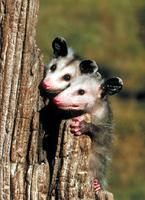
Animal
Animals are many-celled, responsive heterotrophs (eaters of various things). Herbivores eat plants; carnivores eat flesh; omnivores, such as humans, eat nearly everything. Parasites inhabit and subsist in other organisms. The shape of animals, the way they move and how they sense and seize and swallow food suggest that the need to find an organic food source is the most important characteristic of their lives. Animals range from less than 0.1 mm (some rotifers, gastrotichs) to 30 m in length, weighing as much as the 150 t (blue whale).
Animal evolution has resulted in a vast number of adaptations for successful life under all sorts of conditions, so that there are now more kinds of animals than of all other living things combined. It is impossible to keep track of all species that have been formally described, but there are more than one million. Two thousand to 4000 new species are found annually, usually small and inconspicuous, often from remote places (eg, tropical rainforests, the deep sea, Canada's Arctic Archipelago).
Classification
The animal kingdom Animalia is divided into 33 groups (phyla), each one of which has characteristics setting it apart from all others. Most phyla are small, with only a few, or few hundred species.
By far the largest is the phylum Arthropoda ("jointed foot"), with about one million species named. The phylum includes crabs and lobsters, millipedes and centipedes, spiders and a great many small, marine forms, but the most numerous are insects. Even in Cambrian times (544-510 million years ago), arthropods, other than insects which appeared much later, dominated the scene.
The phylum Mollusca ("soft-bodied"), another large and ancient group, includes clams and oysters, snails, octopuses and squids, among other forms. Nematoda ("threadlike") is a phylum of wormlike animals, many of which are parasitic on members of other phyla. Humans are parasitized by such nematodes as pinworms, hookworms, trichina worms and others.
Other phyla commonly seen include Annelida ("little ring," earthworms), Echinodermata ("spiny skin," starfish, sea urchins, sand dollars) and Cnidaria ("nettle," jellyfish and sea anemones). Animals with backbones, vertebrates, are placed in the phylum Chordata and include fish, amphibians, reptiles, birds and mammals. Although chordates may be the animals we are most familiar with, they make up less than 5% of the fauna of the world. Many of the groups are known only to specialists; the animals are so small and obscure they do not even have common names.
Habitats and Distribution
The sea is the most common environment for animals; dry land is the least common. Many animals are dependent on other organisms as parasites or near-parasites. Most of the most successful phyla take advantage of all environments.
Animal distribution depends on geography, climate and historical events. Each continental mass has a unique fauna which has evolved largely independently. Within each continent are distinctive associations of plants and animals isolated by features such as mountains, deserts or forests. Events of the past, such as glaciation or the shifting of land (see Plate Tectonics), have strongly influenced the adaptations of animals. Thus, there are more kinds of animals in the tropics than in the high latitudes, because of more equable climatic conditions, and because conditions have been stable for longer periods, allowing for more complete exploitation of available habitats. The fauna of Canada, like its physiographic regions and vegetation, reflects its North American association, and the effects of the glaciers which only 10 000 years ago covered about 97% of Canada's surface.
Some vertebrates are found nearly everywhere in Canada, eg, northern pike, walleye, whitefish, Canada goose, mallard, ruffed grouse, beaver, muskrat, moose, black bear and weasel. Others are restricted, and almost unique to Canada, eg, muskoxen in the Arctic Lowlands; mountain goats in the Western Cordillera; pronghorns in the Interior Plains; lake trout around the Shield; and snow geese across the Shield and eastern Arctic. The rich assemblage of animals in the St Lawrence Lowlands, a northern extension of southerly environments, includes bowfins among the fish, more amphibians and reptiles than anywhere else in Canada, the opossum and many birds.
Significance
Canada's animals have influenced its history through their effects on the fur trade, fisheries and settlement, as well as on story and song. Canada's heritage includes tales of fierce mosquitoes and black flies, vast herds of bison, calls of loon and coyote, busyness of beavers and friendliness of whiskey jacks (or gray jay). The fear inspired by grizzly bear and timber wolf, the sight of killer whale and sea otter, the skill needed to catch Atlantic salmon and the pleasure of dining on Winnipeg goldeye are legendary. It is a rich heritage that must be preserved.

 Share on Facebook
Share on Facebook Share on X
Share on X Share by Email
Share by Email Share on Google Classroom
Share on Google Classroom


